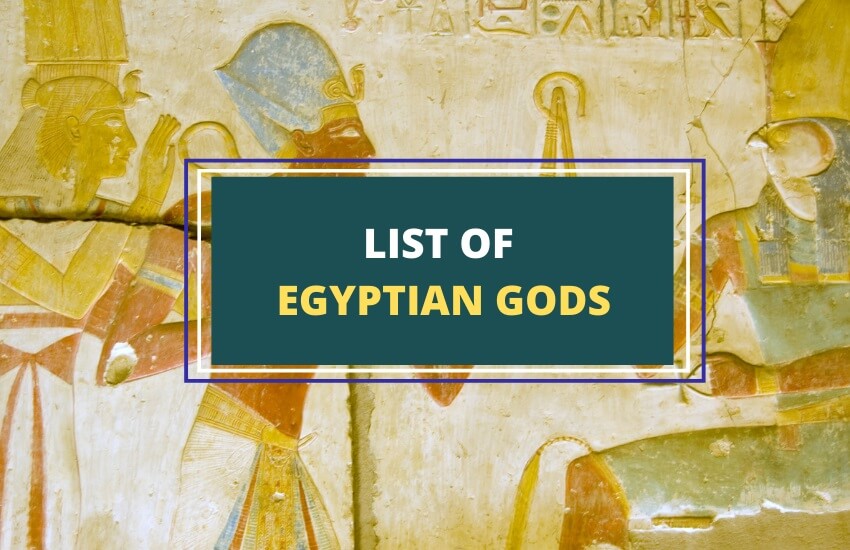
Table of Contents
The Egyptian pantheon is full of many deities, each with its own significance, myths and symbolism. Some of these beings goes through several transformations between the different Egyptian kingdoms, which can make it confusing to identify them. In this article, we cover 25 of the most popular gods of ancient Egypt, and why they’re important.
Ra
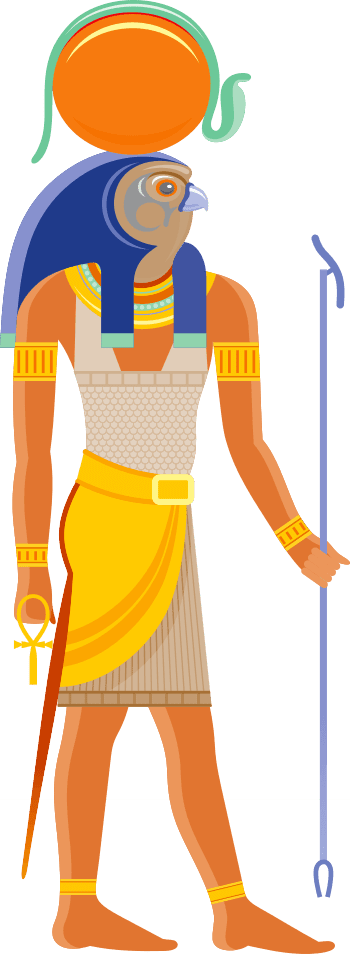
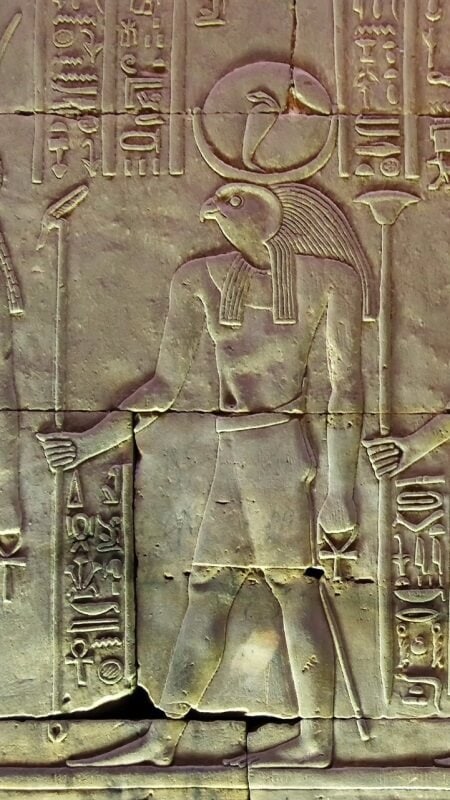
Ra is one of the most famous gods of ancient Egypt. He was both the sun god and was the main deity in Egypt by the Fifth Dynasty or around 25th and 24th centuries BCE. Ra was also believed to be Egypt’s first pharaoh back when gods roamed the Earth with people. As a result, he is also worshipped as the god of order and kings. After his ascension, Ra was said to cross the sky on his ship or “solar barge” as the sun, setting in the west every evening and traveling the underworld, Duat, in order to rise in the East again in the morning. During Egypt’s Middle Kingdom, Ra was also often affiliated and combined with other deities such as Osiris and Amun.
Osiris

Osiris took over the world from Ra when the latter grew old and ascended to the heavens. Osiris was the son of Geb and Nut and was a wise and just pharaoh – he taught the people of Egypt how to farm and how to build large cities. Legend says, however, that he was eventually betrayed by his jealous brother Set, who tricked him into lying in a golden coffin. Set killed Osiris and cut him into pieces as he was in the coffin. And even though Osiris’ wife Isis eventually managed to resurrect him and make him into the first mummy, Osiris wasn’t fully alive anymore. Since then, he became the god of the underworld where he judged the souls of the dead.
Isis
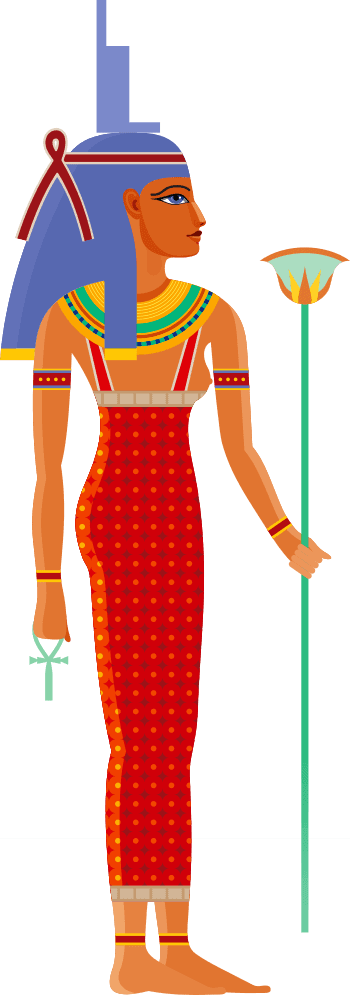
Isis was the sister and wife of Osiris and the goddess of magic, and is often portrayed with large wings. In a popular myth, Isis poisoned Ra with a snake, and would only heal him if he revealed his true name to her. After he told her his name, she healed him and removed the poison, but she had become powerful with the knowledge of his name and could manipulate him to do anything.
In one version, Isis used her power to force Ra to move further away from the world, as his tremendous heat was killing everything in it. In the other version, she used the power to miraculously fall pregnant from the mummified Osiris.
After Osiris’ death at the hands of Set, Isis managed to resurrect her husband and he then retired to rule over the Underworld. Isis encouraged their son Horus to avenge his father by battling Set. Portrayed as a beautiful winged woman, Isis was worshipped as a clever and ambitious goddess as well as a loving spouse.
Set
The brother of Osiris and father of Anubis, Set or Seth is a god with a mixed reputation. He has always been worshipped as the god of the desert, storms, and foreign lands but he used to be viewed positively by the ancient Egyptians. For a long time, he was believed to ride the sky with Ra on his solar barge every day, protecting him from the armies of the evil serpent, Apep.
In the days of Osiris, however, the legend of Set killing his brother and usurping his throne became prevalent in Egypt and turned the god’s reputation in a more negative direction. He began to be seen as an antagonist in the stories of Osiris and Horus.
Thoth
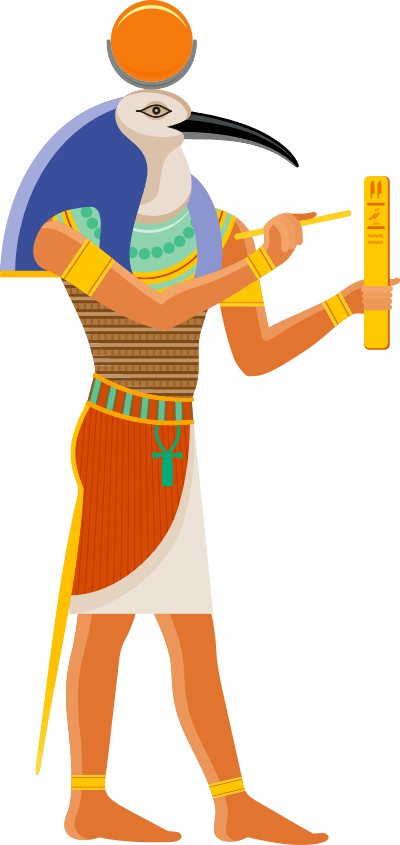

Thoth was worshipped as the god of wisdom, science, magic, and hieroglyphs in ancient Egypt. He was depicted as a man with the head of either an ibis bird or a baboon, as both animals were sacred to him.
Together with his wife Ma’at, Thoth was said to live on Ra’s solar barge and travel with him through the sky. While Thoth never got the “chief” role in Egypt’s pantheon the way Ra, Osiris, Set, Horus, and others did, Thoth was always revered as a vital god in Egyptian mythology.
Horus

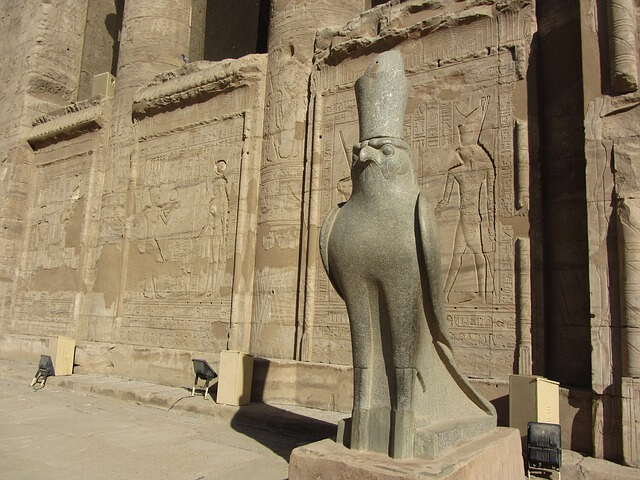
The son of Osiris and Isis, and the nephew of Set, Horus is usually portrayed as a man with a falcon head. He’s worshipped as the god of the skies but also of kingship and remained the chief deity in the Egyptian pantheon until the era of Roman Egypt. In the oldest Egyptian myths, he was known as the tutelary or guardian deity in the Nekhen region of Upper Egypt but he eventually rose to the top of the Egyptian pantheon. After Horus’ uncle Set usurped the divine throne from Osiris, Horus battled and defeated Set, losing an eye in the process but also winning the throne. The Eye of Horus is an important symbol in itself, representing protection and guardianship.
Bast
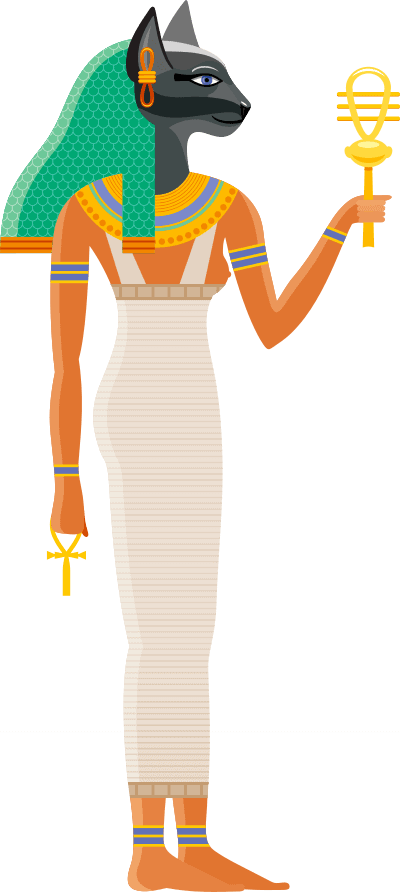
It’s no secret that the ancient Egyptians used to worship cats. That’s largely because of how useful these pets were for them – they used to hunt snakes, scorpions, and other nasty pests that plagued the Egyptian’s everyday lives. Often pictured as a cat or a lioness with jewels on her head and neck, and even a knife in her foot, Bast was the goddess of the Egyptians’ feline pets. She was also sometimes depicted as a woman with a cat’s head.
A protective goddess, Bast or Bastet, was the patron goddess of the city Bubastis. She was often connected with Sekhmet, another of Egypt’s protective goddesses. While the latter was portrayed as a warrior, however, Bast had a more subtle yet important protective role.
Sekhmet

Sekhmet, or Sachmis, was a warrior goddess and a goddess of healing in Egyptian mythology. Like Bast, she was often portrayed with a lioness’ head but was a much more war-loving deity. She was particularly viewed as the protector of pharaohs in battle and she was the one that would carry the pharaohs to the afterlife if they died in battle. This puts her in a somewhat similar position to that of Odin’s valkyries in Norse mythology.
Bast, on the other hand, was more of a common people’s goddess which is likely why she is the more famous of the two today.
Amun

Amun or Amon is a major Egyptian deity, typically worshipped as the creator god in Egyptian mythology and the patron god of the city of Thebes. He is a part of the Ogdoad, the pantheon of 8 major deities in the city of Hermopolis. He gained a much wider national importance later on when Egypt was unified and Amun became “fused” with the sun god Ra, from then on worshipped as Amun-Ra or Amon-Ra.
After Alexander the Great conquered large swathes of the Middle East and Egypt, in many of the territories with mixed Greek and Egyptian influences Amun started being identified with Zeus and worshipped as Zeus Ammon. Together with Osiris, Amon-Ra is the most widely recorded Egyptian deity.
Amunet
Amunet, or Imnt, is one of the primordial deities of ancient Egypt. She’s the female counterpart of the god Amun and is also a part of the Ogdoad pantheon. The name “Amunet” was popularized by 20th century Hollywood movies as an Egyptian queen but she was actually one of the oldest Egyptian gods. Her name comes from the Egyptian feminine noun jmnt and means “The Hidden One”. This is similar to Amun’s name which also has a similar meaning but comes from the masculine jmn. Before Amun fused with Ra, he and Amunet were worshipped as a pair.
Anubis
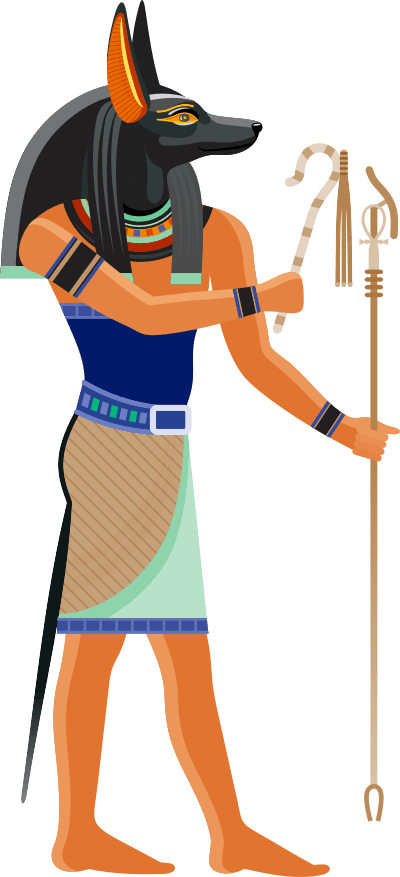
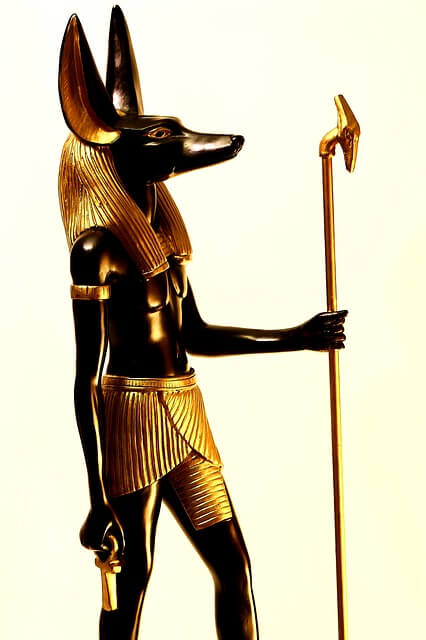
Son of the “evil” god Set, Anubis is the god of funerals. Despite his relation to death, he was actually revered and loved by the Egyptians who were firm believers of life after death. Anubis was the one who helped Isis mummify and resurrect her husband Osiris after Set killed him. Anubis was also believed to care for every soul in the afterlife and prepare them for the Hall of Judgement where Osiris would judge their life and worth. Anubis wore the head of a jackal as the Egyptians associated these animals with the dead.
Ptah

Ptah is the husband of the warrior goddess Sekhmet and an ancient Egyptian deity of craftsmen and architects. He was also believed to be the father of the legendary sage Imhotep and the god Nefertem.
He was also worshipped as a creator god as he existed before the world itself and thought it into existence. As one of the oldest deities in Egypt, Ptah was the recipient of many other honors and epithets – the lord of truth, the master of justice, the lord of eternity, the begetter of the first beginning, and more.
Hathor

Hathor had many different roles in Egyptian mythology. She was portrayed either as a cow or as a woman with cow’s horns and a sun disk between them. That’s because in many legends she was believed to be Ra’s mother. At the same time, she acted as Ra’s feminine counterpart and as the Eye of Ra – the very sun disk which the sun god used against his enemies.
Her portrayal as a cow was actually flattering as cows were associated with maternal care. In other myths, however, she was also believed to be the mother of Horus instead of Isis. This is supported by her very name which in ancient Egyptian is read as ḥwt-ḥr or House of Horus.
Babi
A lesser known god, who was popular back then, and a somewhat amusing deity, Babi was the god of sexual aggression as well as Duat, the Underworld. Babi was portrayed as a baboon because he was the god of wild baboons, animals well-known for their aggressive tendencies. This puts him in contrast to Thoth for whom baboons are also sacred. However, while with Thoth baboons are associated with wisdom, the exact opposite is true for Babi. This god’s name translates as Bull of the baboons, i.e. the chief baboon.
Khonsu
The son of Amun and the goddess Mut, Khonsu was the god of the moon in ancient Egypt. His name translates to a traveler which likely refers to the moon traveling across the sky every night. Like Thoth, Khonsu was a god that marked the passage of time as the ancient Egyptians used the phases of the moon to mark time. He was also believed to play an instrumental role in the creation of all living things in the world.
Geb and Nut
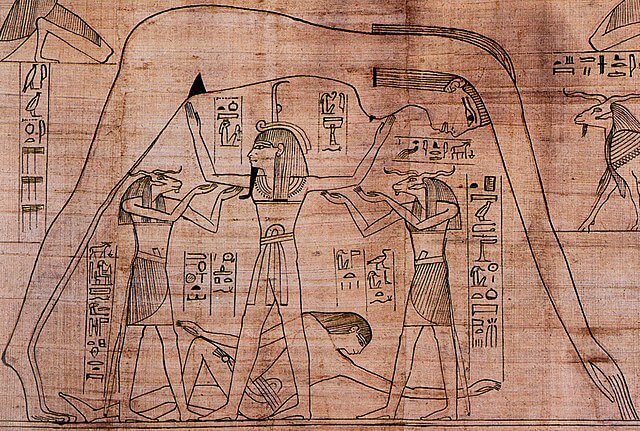
Many deities in ancient Egypt came in pairs but were also important individually. However, Geb and Nut simply have to be talked about as one. Geb is the male god of the earth and Nut is the female goddess of the sky. He was often portrayed as a brown-skinned man, laying on his back while covered in rivers. Nut, on the other hand, was portrayed as a blue-skinned woman covered with stars stretching above Geb.
The two of them were siblings but were helplessly attracted to each other. The sun god Ra knew of a prophecy that Geb and Nut’s children would eventually overthrow him, so he tried his best to keep the two apart. Eventually, Nut had four or five children, depending on the myth, from Geb. These were Osiris, Isis, Set, and Nephthys, with Horus often added as a fifth child. Naturally, the prophecy came true, and Osiris and Isis overthrew Ra and took his throne, followed by Set and then Horus.
Shu
Shu is one of the primordial gods in Egyptian mythology and he’s the embodiment of air and wind. He’s also the god of peace and lions, as well as the father of Geb and Nut. As the wind and air, it’s Shu’s job to keep Geb and Nut apart – a job he did well most of the time except whenever Osiris, Isis, Set, and Nephthys were conceived.
Shu is one of the nine deities in the Ennead – or main pantheon – of Heliopolis cosmology. He and his wife/sister Tefnut are both children of the sun god Atum. The three of them are accompanied in the Ennead by their children Geb and Nut, their grandchildren Osiris, Isis, Set, and Nephthys, and sometimes by Osiris and Isis’ son Horus.
Kek
In the Hermopolitan Ogdoad pantheon of Egyptian gods, Kek was the personification of cosmic darkness. His female name was Kauket and the two of them were often thought of as representing the night and day. The two of them were depicted as humans with various different animal heads. Kek often had the head of a snake while Kauket – the heads of either a cat or a frog.
Curiously enough, “kek” also has the modern meme meaning of “lol” in many message boards and is often connected with another meme – Pepe the Frog. While this connection was coincidental it has sparked a lot of interest in the ancient Egyptian deity.
Bes
Bes is a god most people are surprised to find in the Egyptian pantheon as he’s a dwarf. While we usually associate dwarves with Norse mythology, Bes was a very popular, albeit minor, deity in Egypt.
He was usually portrayed as a rather ugly person with a lion’s mane and a pug nose. He was a powerful protector of mothers and children, however, and was believed to scare off evil spirits. People in Egypt believed that those born with dwarfism were inherently magical and brought luck to the household.
Tawaret
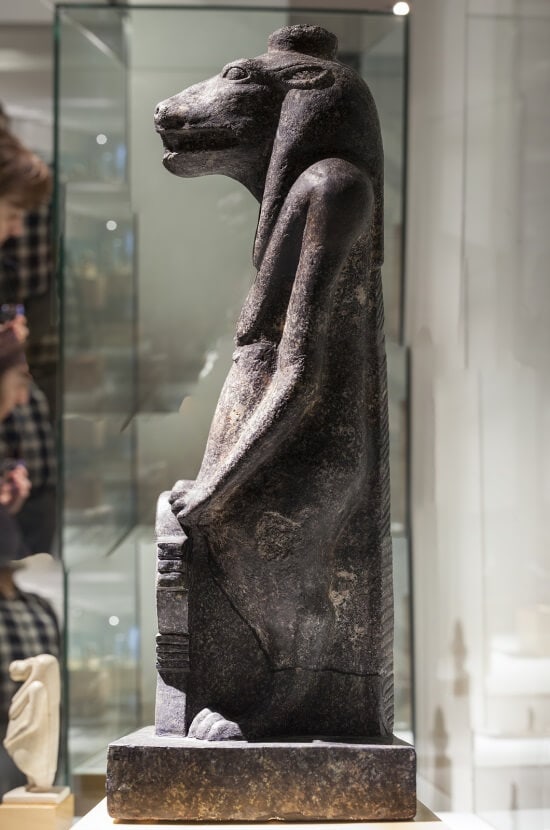
Just as the Egyptians associated cows with motherly care and protection, they also thought the same of female hippos. They were afraid of hippos in general as the animals are overly aggressive but the Egyptians nevertheless recognized motherly care in that aggressiveness toward outsiders. That’s why it’s not surprising that the goddess protector of pregnant women Tawaret was portrayed as a female hippo.
Tawaret was portrayed as an upright female hippo with a big belly and often Egyptian royal headgear on her head. She was said to scare off evil spirits during pregnancies and childbirth just like Bes, and the two were thought of as a pair.
Nephthys
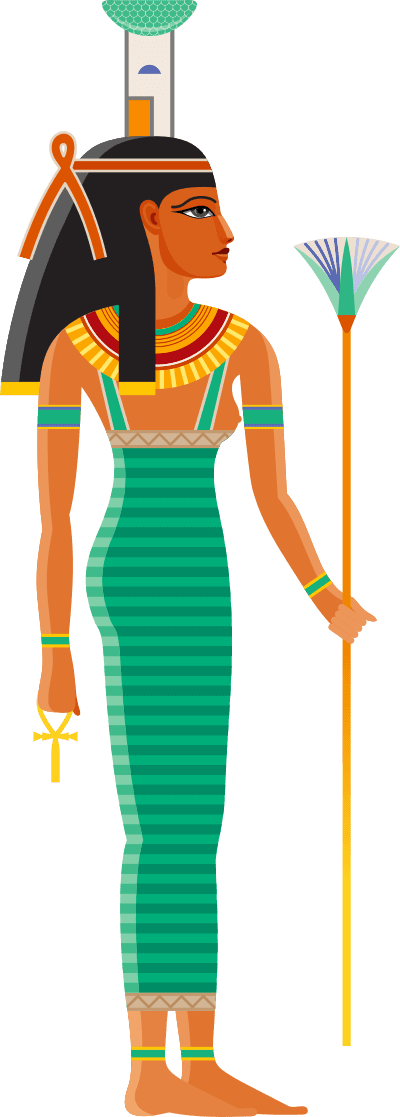
Nephthys is the least talked about of the four children of Geb and Nut as Osiris, Isis, and Set are much more well-known nowadays. She was the goddess of rivers and was very much beloved by the ancient desert-dwelling Egyptians.
Just as Osiris and Isis were married, so were Set and Nephthys. The god of desert lands and foreigners didn’t get along with his river goddess wife too well, however, so it’s no surprise that Nephthys helped Isis resurrect Osiris after Set killed him. She mothered Anubis, the god of funerals and mummification, and he too went against his father and helped in Osiris’ resurrection.
Nekhbet
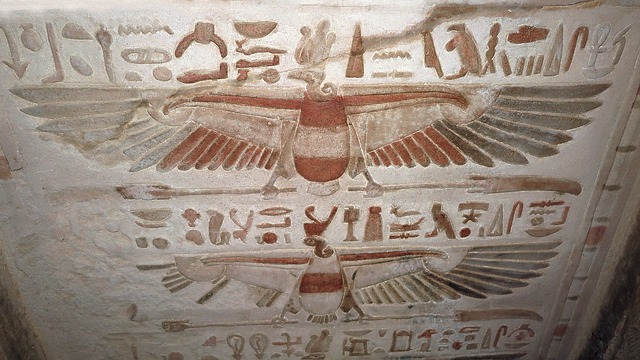
One of the oldest deities in Egypt, Nekhbet was first a local vulture goddess in the city of Nekheb, later known as the city of the dead. She did eventually become the patron goddess of all of Upper Egypt, however, and after the kingdom’s unification with Lower Egypt, she was one of the two most honored gods in the entire kingdom.
As a vulture goddess, she was the goddess of the dead and the dying but was also the protector goddess of the pharaoh. She was often portrayed as hovering over him protectively rather than menacingly.
Wadjet
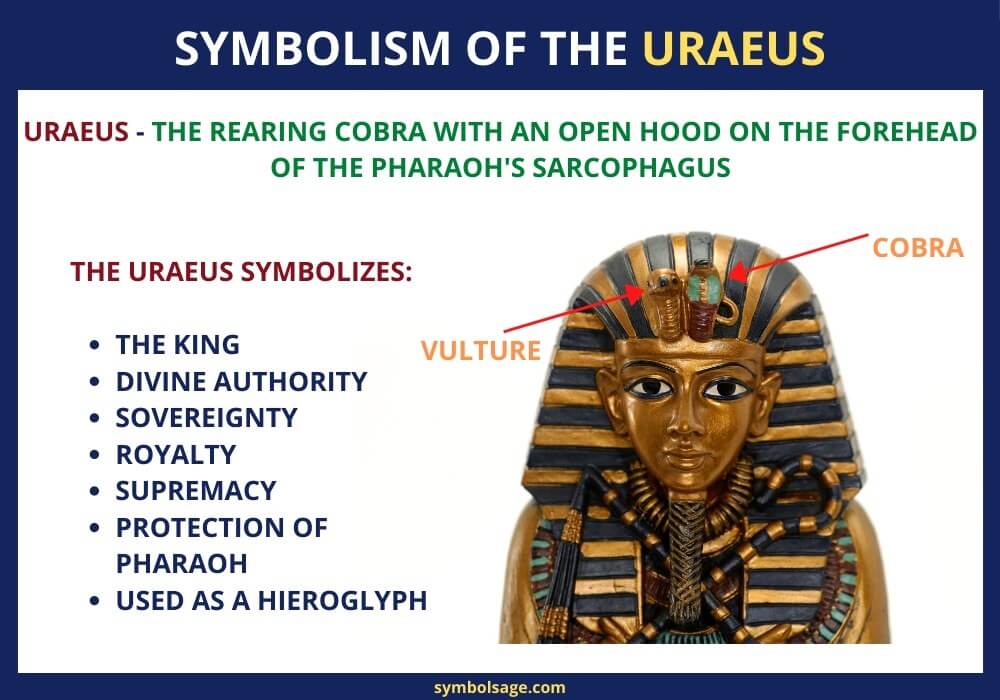
The corresponding patron deity of Lower Egypt to Upper Egypt’s Nekhbet, was Wadjet. She was a serpent goddess, often portrayed with the head of a snake. Pharaohs of Lower Egypt would wear the symbol of the rearing cobra called Uraeus on their crowns and that symbol would remain on royal headgear even after the unification of Egypt. In fact, the Eye of Ra sun disk symbol that emerged centuries later continued to feature two Uraeus cobras on the sides of the disk, in homage to Wadjet.
Sobek
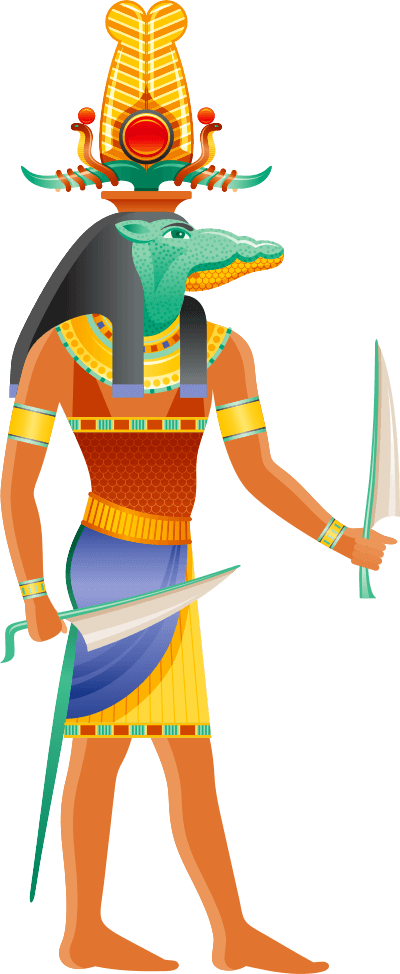
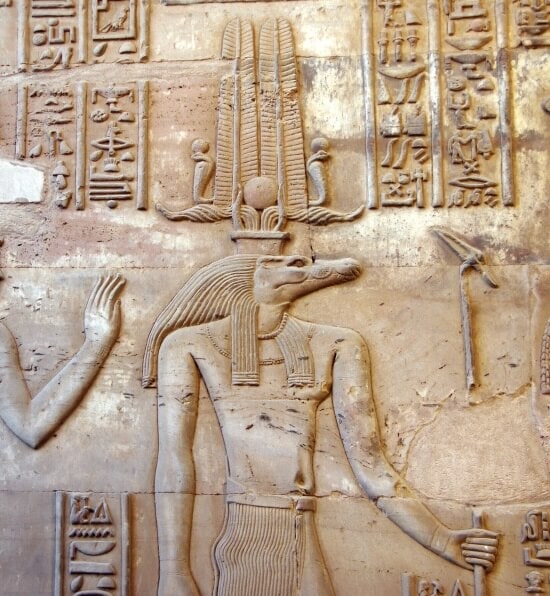
The god of crocodiles and rivers, Sobek was often portrayed as a crocodile or a man with a crocodile head. As the fearsome river predators were a menace for many Egyptians, Sobek was often feared by the people of Egypt.
At the same time, however, he was also honored as the god of pharaohs in some cities and as a powerful military deity, likely because crocodile-infested waters would often stop advancing armies. Funnily enough, he was also a god of increased fertility – that’s likely because of crocodiles laying 40-60 eggs at a time. It was also said in some legends that the world’s rivers were created from Sobek’s sweat.
Menhit
Originally a Nubian war goddess, Menhit was portrayed as a woman with a lioness’ head and royal headgear. Her name translates to she who massacres. She was also sometimes depicted on pharaohs’ crowns instead of the traditional Uraeus symbol. That’s because she became known as a crown goddess after she was adopted by the Egyptians. Menhit also personified the brow of Ra and was sometimes identified with another feline war goddess Sekhmet, but the two were distinctly different.
SOURCE:Ancient Egyptian Gods (List with Pictures) – Symbol Sage